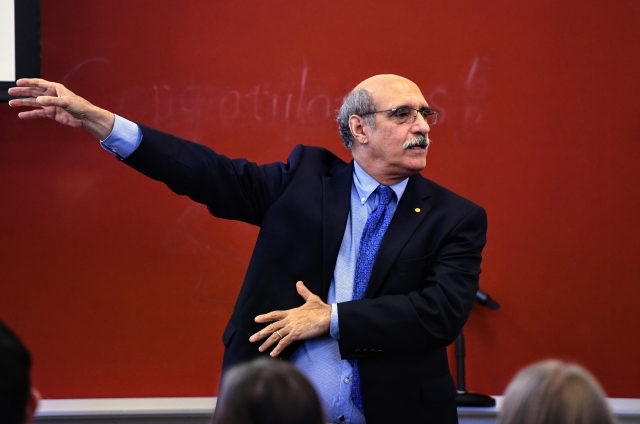
Encouraging students and faculty to “ignore the people who say ‘this cannot be done,’” Nobel Laureate Martin Chalfie, Ph.D., delivered the 2018 Dr. Jaya Haldar Memorial Seminar, “GFP: Lighting Up Life,” in the D’Angelo Center on St. John’s University’s Queens, NY, campus.
“Many discoveries are purely accidental,” said Dr. Chalfie, University Professor of Biological Sciences at Columbia University. “If you want to make discoveries, you have to do much experimenting, because strange stuff is going to come up. And once it comes up, if you are lucky enough—you notice it, and you pursue it.”
Dr. Chalfie’s discovery of green fluorescent protein (GFP) earned him the Nobel Prize in Chemistry in 2008. GFP is found in the bioluminescent jellyfish Aequoreavictoria and has revolutionized the way science is studied, allowing researchers to visualize organelles and proteins in living cells, tissues, and organisms.
During his lecture, he stressed the importance of employing unconventional approaches to overcome obstacles. In his early days of GFP research, Dr. Chalfie’s lab was limited because his microscope was “a piece of junk.”On the verge of a breakthrough, and in need of higher quality equipment, he called every microscope sales representative in New York in hopes of trying out new units for a few months.
“Needless to say,” he said, “all of our early experiments were done on borrowed microscopes.”
Luck plays a very important role in science, Dr. Chalfie noted, explaining that, in 1992, there were at least four other labs performing similar research on GFP. “Why did they fail and we succeed?” he asked. “I think it was because they were careful, and we were sloppy.”
He clarified that assessment by explaining that in the early nineties, there were two ways of acquiring DNA for experiments. “If you wanted to be careful, you used e-coli,” he said. Instead, his group secured DNA using a much less reliable method.“Our thought was that even if it was 99 percent bad, we had that one percent chance that it could work.” Dr. Chalfie and his fellow researchers were fortunate enough to beat those long odds.
“Ultimately, what made GPF something that the Nobel committee noticed, were the thousands of people who used it and did things that we would never have imagined,” he said. “They made it important simply by adding their own ideas.”
Today, scientists continue to explore the many varied uses of GFP, including HIV research, mapping the neural circuits of the brain, and even the detection of land mines.
The Dr. Jaya Haldar Memorial Seminar was founded in 2015 by Dipak Haldar, Ph.D., in memory of his late wife, Jaya Haldar, Ph.D., who passed away in 2014. The Haldars were both beloved professors at St. John’s University before retiring in 2010.
“This was the best seminar I have attended in my 35 years in science,” said Ales Vancura, Ph.D., Professor and Chair, Biological Sciences, St. John’s College of Liberal Arts and Sciences. “Dr. Chalfie told the story of the discovery of green fluorescent protein in a way that was worthy of a Nobel Prize laureate. The talk, infused with humor and humanism, was fascinating to professors, but also accessible and inspirational to students.”
Alison Preston, a Biology major, saw many parallels between Dr. Chalfie’s experiences as a researcher and her own. “It was refreshing to hear about all the different failures he experienced throughout his career,” said the senior from Houston, TX. “Despite that, his discovery has been applied to so many different fields. I hope that in the future, my research can also have broad applications.” Alison’s research focuses on manipulating DNA into different shapes, strengthening the strands with ultraviolet light, and then testing the strength of the DNA.
“It is not every day that you get to meet someone who has won a Nobel Prize,” said Michael Padron, a junior majoring in Biology. “I have read about GFP in textbooks, but to learn about its discovery from one of the people who actually discovered it was incredible.”
Michael was inspired, not only by Dr. Chalfie’s impressive body of work, but by his humor, sincerity, and humility. “It was interesting to hear about his successes and his missteps,” he said. “The key is to never give up and to believe in your ideas.”
Related News
Founder’s Week Celebration Lights Hearts on Fire at St. John’s
St. Vincent de Paul was a practical man of action. He was a master at building teams composed of the most talented people suited to his cause. His passion motivated others; he set hearts on fire.
New Academic Year Celebrated by Honoring and Welcoming Faculty
On the eve of each new academic year—before the bustle that naturally comes with new and returning students—St. John’s University always takes a moment to pause and reflect on the critical contributions made by its faculty, honoring their service and welcoming its newest members.
St. John’s Embraces the AI Frontier: Preparing Students for a Human-Centered Future
At St. John’s University, artificial intelligence (AI) isn’t just a trending topic—it’s fast becoming an integral part of how students learn, create, and prepare for the world ahead.
